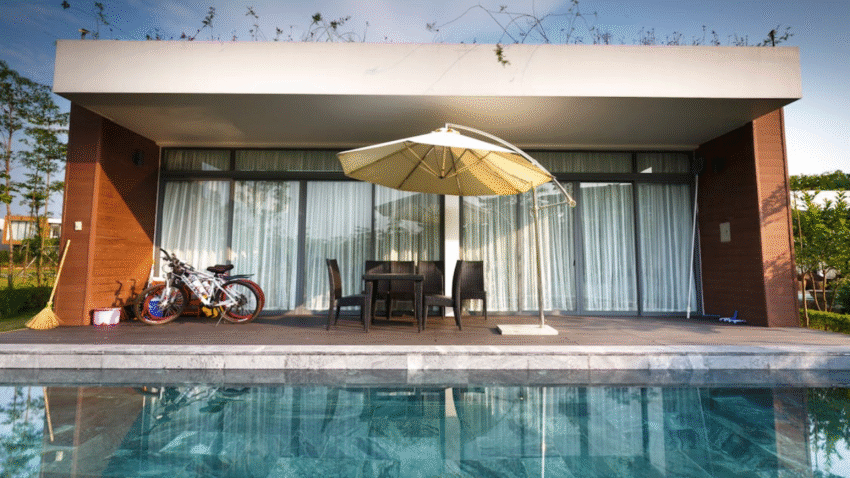Introduction
Wet pool decks are one of the most common causes of backyard injuries. Slippery surfaces can lead to falls, bruises, broken bones, and even head injuries — especially when kids are running around. In this complete guide, you’ll learn how to prevent slipping on wet pool decks using practical, affordable, and long-lasting methods. From surface treatments to behavioral tips, we’ll help make your pool area safer for everyone.
Why Preventing Slips Around the Pool Matters
Pool decks are exposed to constant moisture, sun, and foot traffic. When surfaces become slick — especially smooth concrete, tile, or stone — they pose a major hazard. Preventing slips and falls isn’t just about safety; it also helps you:
- Avoid injuries and liability
- Protect guests and family
- Extend the life of your deck
- Maintain peace of mind during pool time
Creating a non-slip environment should be a top priority for any pool owner.
Step-by-Step Guide to Preventing Slips on Wet Pool Decks
Step 1: Choose a Non-Slip Surface Material
If you’re installing a new pool deck or resurfacing an old one, opt for materials that offer natural grip:
- Broom-Finished Concrete: Textured for traction
- Stamped Concrete with Anti-Slip Additive
- Paver Stones: Textured and slip-resistant
- Rubber Pool Decking: Soft, cushioned, and non-slip
- Textured Wood or Composite Decking (for above-ground pools)
💡 Tip: Avoid glazed tiles or smooth stone around pools — they become dangerously slick when wet.
Step 2: Apply an Anti-Slip Coating or Sealant
If your pool deck is already installed but feels slippery, you can improve traction with a non-slip coating. These sealants add texture and grip to the surface.
Steps:
- Clean the deck thoroughly with a degreaser or power washer
- Let it dry completely
- Apply a non-slip concrete or paver sealant with a roller or sprayer
- Let cure for 24–48 hours before use
Many coatings contain fine aggregate or grit particles to improve traction without changing the look of your deck.
⚠️ Caution: Follow manufacturer instructions for drying time and safety precautions.
Step 3: Use Anti-Slip Mats or Textured Treads
For targeted slip prevention:
- Place non-slip rubber mats at high-risk areas (steps, pool entry points, diving boards)
- Apply grip tape or treads on wooden or composite surfaces
- Use modular interlocking deck tiles with anti-slip textures for large areas
These solutions are ideal for renters or temporary fixes.
Step 4: Keep the Pool Deck Clean and Free of Algae
Dirt, mildew, and algae buildup can turn even textured surfaces into a slipping hazard. Routine cleaning is essential.
How to clean safely:
- Use a pressure washer every 2–4 weeks
- Apply an algaecide or bleach solution (diluted) for stubborn growth
- Scrub with a stiff-bristled broom
- Rinse thoroughly and allow to dry
💡 Pro Tip: Check for puddles or areas with poor drainage that stay wet longer — these spots grow algae faster.
Step 5: Improve Drainage Around the Pool
Standing water is the #1 cause of slippery decks. Ensure proper drainage by:
- Installing deck drains or trench systems
- Smoothing uneven areas that collect water
- Sloping the deck slightly away from the pool
- Clearing clogged drains or gutters regularly
This helps keep surfaces dry and reduces mold, mildew, and algae growth.
Step 6: Establish Poolside Safety Rules
Even with great surfaces, behavior matters. Set simple rules for swimmers and guests:
- No running on the deck
- Use handrails when entering and exiting
- Dry feet before stepping on slick materials
- Keep pool toys, floaties, and chairs out of walking paths
Consider posting a pool safety sign as a visual reminder.
Common Mistakes to Avoid
- Using Smooth Tile or Stone
Shiny surfaces may look nice, but they become ice-rink slick when wet. - Skipping Cleaning
A buildup of grime and algae creates invisible slip hazards — especially in shaded areas. - Ignoring Drainage Problems
Poor water flow allows puddles to sit and grow slippery organic material. - Relying Only on Visual Cues
Even if a deck looks clean, it may still be slippery. Test for grip after rain or cleaning. - Not Reapplying Sealants
Non-slip coatings wear down over time — reapply every 1–3 years for best results.
Extra Tips & Pool Hacks
- Test with Bare Feet: Walk slowly around the deck after rinsing it — areas that feel slick need attention.
- Use Outdoor Rugs with Grip Backing: Adds comfort and traction in lounge areas.
- Install Motion-Sensor Lighting: Ensures people can see where they’re walking at night, reducing trips and slips.
Want to protect kids around the pool too? Read our guide on [how to teach kids pool safety rules].
Conclusion
Slips on wet pool decks can be dangerous — but they’re entirely preventable. With the right materials, surface treatments, and habits, you can create a safer environment around your pool for family, guests, and pets. Whether you’re installing a new deck or upgrading your current one, these simple steps can help you stay ahead of accidents and enjoy worry-free poolside fun.
📌 Bookmark this guide and keep your pool area safe all season long!
